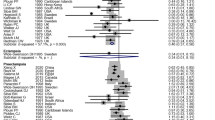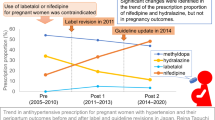Abstract
Objective:
Early initiation of low-dose aspirin (LDA) may reduce preeclampsia risk. We sought to determine whether LDA was beneficial when initiated <17w0d, within a trial of high-risk women enrolled <26w0d.
Study Design:
Secondary analysis of the Maternal-Fetal Medicine Units High-Risk Aspirin study, including women enrolled <17w0d, randomized to LDA (60 mg day−1) or placebo with chronic hypertension (CHTN, n=186), diabetes (n=191) or prior preeclampsia (n=146). The primary outcome was preeclampsia at any time in pregnancy, secondary outcomes were early preeclampsia (<34w0d), late preeclampsia (⩾34w), small for gestational age (SGA; neonatal birthweight <10th %) and composite (early preeclampsia or SGA). Outcomes were compared by exact Χ2-tests.
Results:
Baseline characteristics were similar between treatment groups. Aspirin was associated with a lower rate of late-onset preeclampsia ⩾34w (17.36% vs 24.42%, P=0.047), with a 41% reduction in women with CHTN (18.28% vs 31.18%, P=0.041). There were no other significant differences in the outcome.
Conclusion:
Aspirin initiated <17w0d reduced the risk for late-onset preeclampsia by 29% supporting the practice of early initiation of aspirin in high-risk women.
This is a preview of subscription content, access via your institution
Access options
Subscribe to this journal
Receive 12 print issues and online access
$259.00 per year
only $21.58 per issue
Buy this article
- Purchase on Springer Link
- Instant access to full article PDF
Prices may be subject to local taxes which are calculated during checkout
Similar content being viewed by others
References
Dolea C, AbouZahr C . Global burden of hypertensive disorders of pregnancy in the year 2000. Evidence and Information for Policy (EIP). World Health Organization: Geneva, 2003.
Wallis AB, Saftlas AF, Hsia J, Atrash HK . Secular trends in the rates of preeclampsia, eclampsia, and gestational hypertension, United States, 1987-2004. Am J Hypertens 2008; 21 (5): 521–526.
Walsh SW, Behr MJ, Allen NH . Placental prostacyclin production in normal and toxemic pregnancies. Am J Obstet Gynecol 1985; 151 (1): 110–115.
Sibai B, Dekker G, Kupferminc M . Pre-eclampsia. Lancet 2005; 365 (9461): 785–799.
Ylikorkala O, Makila UM . Prostacyclin and thromboxane in gynecology and obstetrics. Am J Obstet Gynecol 1985; 152 (3): 318–329.
Borzychowski AM, Sargent IL, Redman CW . Inflammation and pre-eclampsia. Semin Fetal Neonatal Med 2006; 11 (5): 309–316.
Bujold E, Roberge S, Lacasse Y, Bureau M, Audibert F, Marcoux S et al. Prevention of preeclampsia and intrauterine growth restriction with aspirin started in early pregnancy: a meta-analysis. Obstet Gynecol 2010; 116 (2 Pt 1): 402–414.
Tohgi H, Konno S, Tamura K, Kimura B, Kawano K . Effects of low-to-high doses of aspirin on platelet aggregability and metabolites of thromboxane A2 and prostacyclin. Stroke 1992; 23 (10): 1400–1403.
Walsh SW . Low-dose aspirin: treatment for the imbalance of increased thromboxane and decreased prostacyclin in preeclampsia. Am J Perinatol 1989; 6 (2): 124–132.
Caritis S, Sibai B, Hauth J, Lindheimer MD, Klebanoff M, Thom E et al. Low-dose aspirin to prevent preeclampsia in women at high risk. National Institute of Child Health and Human Development Network of Maternal-Fetal Medicine Units. New Engl J Med 1998; 338 (11): 701–705.
Villa PM, Kajantie E, Raikkonen K, Pesonen AK, Hamalainen E, Vainio M et al. Aspirin in the prevention of pre-eclampsia in high-risk women: a randomised placebo-controlled PREDO Trial and a meta-analysis of randomised trials. BJOG 2013; 120 (1): 64–74.
Brenner WE, Edelman DA, Hendricks CH . A standard of fetal growth for the United States of America. Am J Obstet Gynecol 1976; 126 (5): 555–564.
Askie LM, Duley L, Henderson-Smart DJ, Stewart LA . Group PC. Antiplatelet agents for prevention of pre-eclampsia: a meta-analysis of individual patient data. Lancet 2007; 369 (9575): 1791–1798.
CLASP Collaborative Group. Low dose aspirin in pregnancy and early childhood development: follow up of the collaborative low dose aspirin study in pregnancy. BJOG 1995; 102 (11): 861–868.
Mayhew TM . Fetoplacental angiogenesis during gestation is biphasic, longitudinal and occurs by proliferation and remodelling of vascular endothelial cells. Placenta 2002; 23 (10): 742–750.
Bdolah Y, Lam C, Rajakumar A, Shivalingappa V, Mutter W, Sachs BP et al. Twin pregnancy and the risk of preeclampsia: bigger placenta or relative ischemia? Am J Obstet Gynecol 2008; 198 (4): 428 e421–426.
Lisonkova S, Joseph KS . Incidence of preeclampsia: risk factors and outcomes associated with early- versus late-onset disease. Am J Obstet Gynecol 2013; 209 (6): 544 e541–544 e512.
Stergiotou I, Crispi F, Valenzuela-Alcaraz B, Bijnens B, Gratacos E . Patterns of maternal vascular remodeling and responsiveness in early- versus late-onset preeclampsia. Am J Obstet Gynecol 2013; 209 (6): 558 e551–558 e514.
Nelson DB, Ziadie MS, McIntire DD, Rogers BB, Leveno KJ . Placental pathology suggesting that preeclampsia is more than one disease. Am J Obstet Gynecol 2014; 210 (1): 66 e61–e67.
Bahado-Singh RO, Akolekar R, Mandal R, Dong E, Xia J, Kruger M et al. First-trimester metabolomic detection of late-onset preeclampsia. Am J Obstet Gynecol 2013; 208 (1): 58 e51–57.
Roberge S, Villa P, Nicolaides K, Giguere Y, Vainio M, Bakthi A et al. Early administration of low-dose aspirin for the prevention of preterm and term preeclampsia: a systematic review and meta-analysis. Fetal Diagn Ther 2012; 31 (3): 141–146.
CLASP (Collaborative Low-dose Aspirin Study in Pregnancy) Collaborative Group. CLASP: a randomised trial of low-dose aspirin for the prevention and treatment of pre-eclampsia among 9364 pregnant women. Lancet 1994; 343 (8898): 619–629.
Wallenburg HC, Rotmans N . Enhanced reactivity of the platelet thromboxane pathway in normotensive and hypertensive pregnancies with insufficient fetal growth. Am J Obstet Gynecol 1982; 144 (5): 523–528.
Schiff E, Peleg E, Goldenberg M, Rosenthal T, Ruppin E, Tamarkin M et al. The use of aspirin to prevent pregnancy-induced hypertension and lower the ratio of thromboxane A2 to prostacyclin in relatively high risk pregnancies. New Engl J Med 1989; 321 (6): 351–356.
American College of O, Gynecologists, Task Force on Hypertension in P. Hypertension in pregnancy. Report of the American College of Obstetricians and Gynecologists' Task Force on Hypertension in Pregnancy. Obstet Gynecol 2013; 122 (5): 1122–1131.
Acknowledgements
The authors thank Dr Ronald Gibbs MD and Dr K. Joseph Hurt MD for their editorial support. Dr Gibbs and Dr Hurt are employed by the University of Colorado and have no disclosures to report. The authors appreciate the assistance of the National Institute of Child Health and Human Development (NICHD) and the MFMUs Network in making the database from the MFMU High-Risk Aspirin trial available for secondary analysis. The contents of this report represent the views of the authors and do not represent the views of the Eunice Kennedy Shriver NICHD MFMUs Network or the National Institutes of Health. This analysis was supported by the University of Colorado Department of Obstetrics and Gynecology. The original study on which the present article is based was funded by the National Institute of Child Health and Human Development. The findings were presented as a poster at the 34rd annual meeting of the Society for Maternal-Fetal Medicine, 3 to 8 February, 2014, New Orleans, LA, USA.
Author information
Authors and Affiliations
Corresponding author
Ethics declarations
Competing interests
The authors declare no conflict of interest.
Rights and permissions
About this article
Cite this article
Moore, G., Allshouse, A., Post, A. et al. Early initiation of low-dose aspirin for reduction in preeclampsia risk in high-risk women: a secondary analysis of the MFMU High-Risk Aspirin Study. J Perinatol 35, 328–331 (2015). https://doi.org/10.1038/jp.2014.214
Received:
Revised:
Accepted:
Published:
Issue Date:
DOI: https://doi.org/10.1038/jp.2014.214
This article is cited by
-
What a paediatric nephrologist should know about preeclampsia and why it matters
Pediatric Nephrology (2022)
-
Multiple Gestations and Hypertensive Disorders of Pregnancy: What Do We Know?
Current Hypertension Reports (2021)
-
Health facility readiness and provider knowledge as correlates of adequate diagnosis and management of pre-eclampsia in Kinshasa, Democratic Republic of Congo
BMC Health Services Research (2020)
-
Euploid miscarriage is associated with elevated serum C-reactive protein levels in infertile women: a pilot study
Archives of Gynecology and Obstetrics (2020)
-
The Role of Aspirin for Preeclampsia Prevention in Women with Diabetes
Current Diabetes Reports (2020)



